You can also be interested in these:
- AMD Low Framerate Compensation (AMD LFC) explained
- AMD FidelityFX Super Resolution 2.2 reinventing the game
- AMD Zen 3 vs Zen 4: The evolution and revolution
- How to uninstall AMD Gaming Evolved
Gamers will always be obsessed with FPS. They will go great lengths just to benefit from a few more frames per second. The last couple of years there has been a growing trend in graphics technology to rely even more on the software side of things to achieve even more FPS and hence, an edge in performance. This implementation takes multiple names: Image re-scaling, super sampling and super resolution, depending on who creates it. We have the Nvidia DLSS and the Intel XeSS Super Sampling, and in response to these, the AMD FidelityFX. In this article we will be diving a lot deeper in the later.

Processing 3d graphics has a high hardware performance cost. The titans in the graphics processing industry have gone back to the drawing board to come up with their own way to improve graphics performance and alleviate this burden. For this reason, AMD created FidelityFX Super Resolution, to improve graphics performance at a software level.
AMD FidelityFX Super Resolution in a nutshell
AMD FSR is an open-source repository given as a GPUOpen alternative for developers to generate high-resolution frames from low-quality equivalents. This is a graphics re-scaling technology that uses more manageable sizes for smoother animations and gameplay in general and simulates a high-res scheme without making all the complex calculations from raytracing and easing up considerably the work of the GPU.
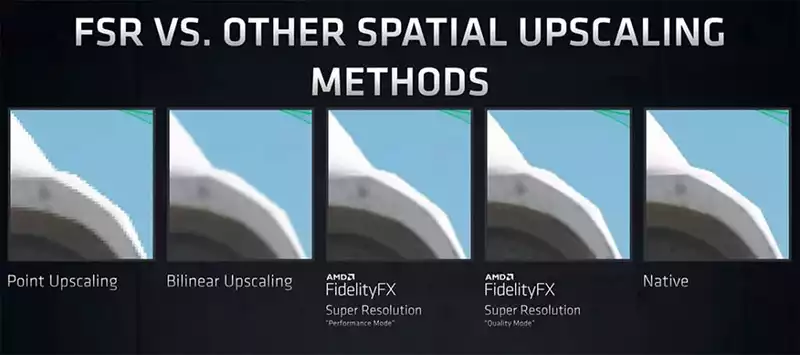
Up to this point no company has achieved a raytracing gaming experience faster than 60 frames per second. The graphics processing on the GPU side has a heavy workload determining all the light bounces and shadow information, as well as caustics, reflections and refraction. Rendering all this information in a high-resolution standard is just too much to handle even for the most top-notch graphics card.
The concept of super resolution introduces an alternative to achieve better graphics by doing all the processing in a medium-size image and re-scaling that image up to the desired resolution afterwards. This technology has its benefits and disadvantages: On the bright side, the output is faster and more optimal, on the other side, whenever there is scaling you will find jagged edges, screen tearing, aberrations and pixelation as well.
The AMD FidelityFX Super Resolution is not only limited to video games and 3D rendering environments. In turn, this technology can also be used in conjunction with RDNA 2, the same architecture present in the PlayStation 5 and the Xbox Series X. This means the FSR can be also used in console gaming. In fact, the first video game taking advantage of this AMD’s technology was Arcadegeddon.
The AMD FSR performs what it’s called a spatial scaling, and it strives for improving the native output image quality, even on performance or quality modes. About the different modes, you can set the FidelityFX Super Resolution in 4 different modes:
| Scale Mode | Scaling factor |
| Performance | 2.0x (favors performance, less quality) |
| Balanced | 1.7x (low quality when in motion) |
| Quality | 1.5x (native res. similar + performance) |
| Ultra Quality | 1.3x (same as native, sometimes better) |
To have an idea of the real benefit of the AMD FidelityFX Super Resolution technology, if we use 4K resolution, we could have up to 2.6 times more performance in our gameplay. That means going from 99 FPS in a normal setup up to 259 FPS, which are the figures we are obtaining right now from games like. Rift Breaker.
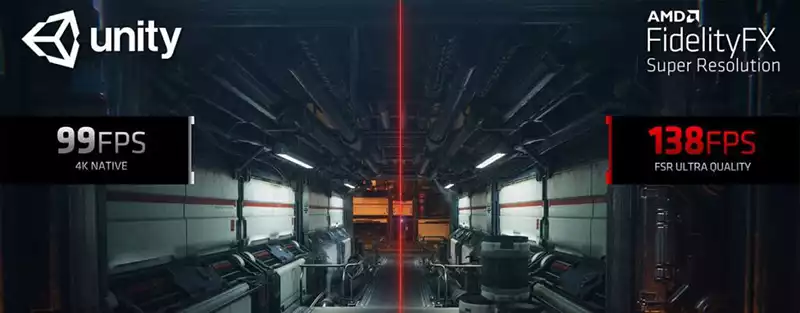
There is another layer of complexity with AMD’s FSR: The dynamic scaling factor. When playing video games, there are peak performance moments you need to sacrifice a little bit of quality to have the smoothest gameplay possible. This is where dynamic scaling comes in, reducing the rendering work almost in half, compared to the native resolution. This is a feature still in development, but it will introduce amazing performance gains where the drop in quality will be more severe, depending on the scale mode selected.
How does AMD FidelityFX Super Resolution work?
Have you thought about how you can upscale an image without getting a disastrous mess in the end? In a nutshell, FSR uses an algorithm which detects and regenerates high-resolution edges from a sample image. Unlike Nvidia’s DLSS, FSR rescales and enhances the quality and performance of our games even in constant movement.
This is all done in a two-phase process. There is a first scaling step, called Edge-Adaptive Spatial Upsampling (EASU). On this step the system analyzes the edges and frames the screenshot according to the on-screen elements, then it detects the gradients taking the starting and ending reference pixels. Lastly, the second process or Robust Contrast-Adaptive Sharpening (RCAS) renders the pixels of the enhanced image on the screen.
In short, FSR benefits from a clever combination of two scaling processes, one linear, and another non-linear. It gathers as much information possible from the sample image and then creates a pattern at a general level. Then, it starts filling the voids with a more refined representation of the final improved image. Here comes into play complex color and space distribution, dithering and tone mapping calculations.
Will AMD FSR become the games industry standard?
In order to benefit from AMD FidelityFX Super Resolution, the technology has to be implemented in our game or software. This has its clear advantages, as we have already seen, but also demands a certain knowledge and familiarity with the code associated to its implementation.
To give a little more context, FSR was launched amid 2021. By this time, Nvidia’s DLSS had already two years in the market, taking the lead in the games industry and stablishing a stronger brand. Adding the developing time to the whole equation, we will be able to experiment AMD FidelityFX Super resolution from 2022 onwards.
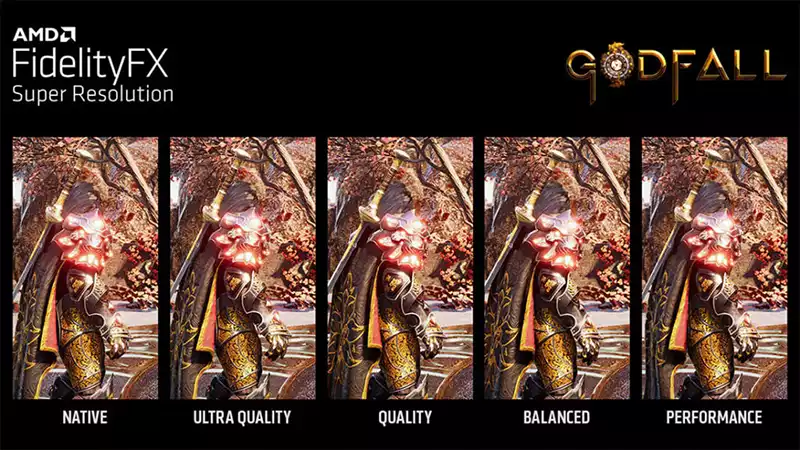
Unless it is an already launched title or franchise with an enormous processing load in the GPU, developers won’t go through the hassle of revisiting the code just to implement a technology they don’t know for sure will give them a tangible advantage in performance. In the near future we will still see Nvidia’s DLSS as the market leader.
AMD has taken a fairly sized piece of the market share cake, and day after day continues adding more game titles to its list. The company recognizes that waiting for developer and game studios support puts them in disadvantage in front of their competition. That is why they came up with Radeon Super Resolution.
What is Radeon Super Resolution?
AMD still has one trick under their sleeve, instead for waiting for developers to implement the FidelityFX Super Resolution, they decided to hand over the code to gamers to be implemented through the Radeon software. This is a client-based version of the FSR, to give gamers a taste of what the technology is capable of, while they wait for games native support with the technology. This implementation is still on development. It was presented as part of AMD’s agenda for 2022 in the CES 2022 event.
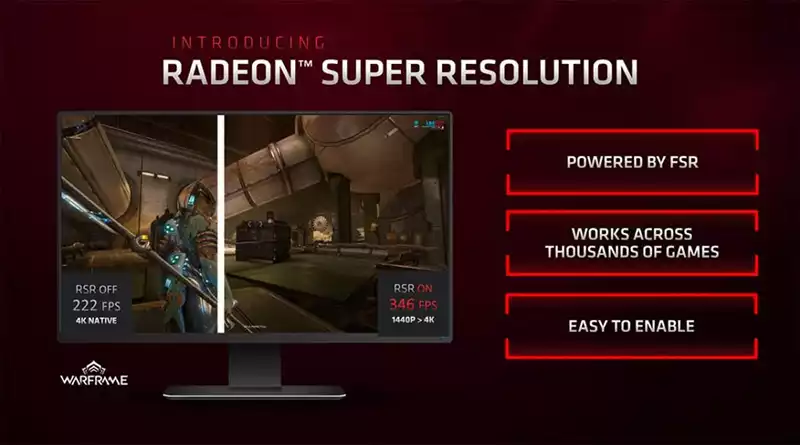
Through the Radeon Software, players will be able to obtain up to 1.7 times more performance, playing at a 1440p 4K with Radeon Super Resolution (RSR). Activating this feature in the settings dashboard the user won’t need to have FidelityFX Super Resolution already built-in, so this can be enabled in all current games, and those coming as well.
AMD is not trying to compete directly with Nvidia’s DLSS. Instead, they are targeting the Nvidia’s Image Scaling technology, which comes integrated with GTX graphic cards. The implementation with the Radeon Software was possible thanks to the newest version of the Adrenalin drivers.
Benefits of AMDs FSR
You won’t need a specialized graphics card to benefit from FidelityFX Super Resolution. It supports all major graphics card manufacturers and APUs. In fact, it also includes support with Nvidia graphic cards. Easy to integrate, and the code base is well documented and straightforward to implement.
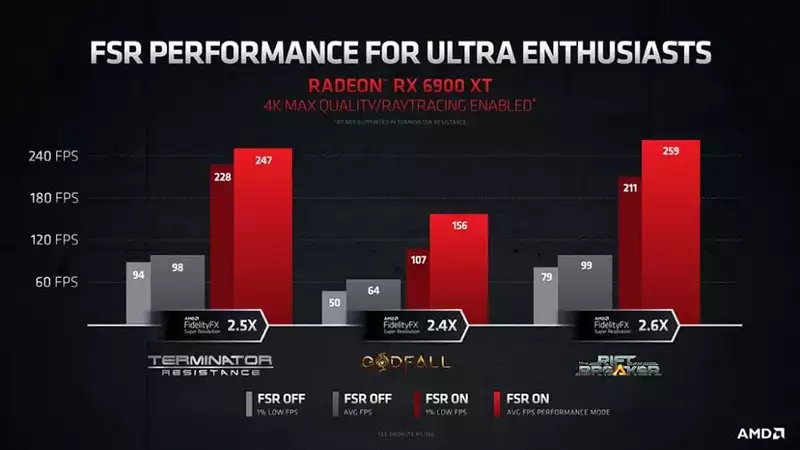
Unlike DLSS, AMD FSR is not based in Deep Learning, hence you will get top performance from the moment you enable it. The Nvidia’s alternative has to go through a learning process to find the best settings possible according to your hardware configuration.
More stories like this
- AMD Low Framerate Compensation (AMD LFC) explained
- AMD FidelityFX Super Resolution 2.2 reinventing the game
- AMD Zen 3 vs Zen 4: The evolution and revolution
- How to uninstall AMD Gaming Evolved
- The Aorus RX 7900 XTX Elite 24G full review
- AMD Radeon R9 M280X GPU review: Powerful and affordable
